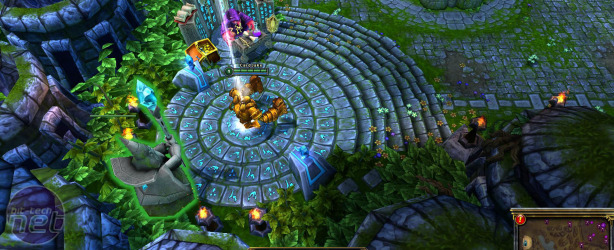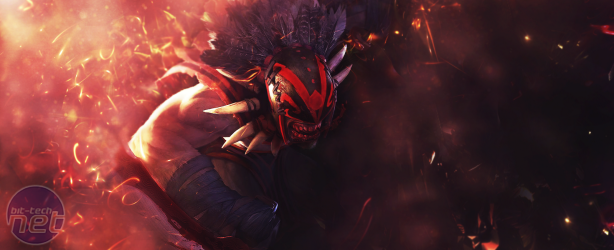Critical Hit: Connect the DOTAs
September 17, 2011 | 11:08
Companies: #bit-gamernet #blizzard #riot-games #valve

Critical Hit: Connect the DOTAs
Question: What do the following games have in common: League of Legends, Dota 2, Heroes of Newerth and Rise of Immortals?Answer: They're all basically the same game - the Warcraft III map Defense of the Ancients. What makes them different from most other games that have jumped on a rolling bandwagon? They're not remotely embarrassed about the fact. Far from it. They're desperate to avoid being seen as breaking a winning formula. If there's any intentional point of distinction, it's what they want people to call the genre. DOTA? MOBA? ARTS? Pick your favourite.
If you haven't played any of them, here's the basic gist. Players are split into two teams, typically five players on each, at the top right and bottom left. Everyone controls a single hero unit, with the main objective being to punch through to the other side's base and destroy it. To help you, each base generates a constant stream of weaker enemies that run straight down one of the three main paths connecting the bases, fighting whatever they run into, including turret defences. Players level up and earn gold to buy equipment by killing things, including monsters in a central forest area, though this doesn't persist between rounds. There's a lot more to it as well, but you get the idea.
If it sounds simple... it's not. There's a hellish amount of stuff to keep track of, from the abilities of individual heroes to the importance of landing the last hit on enemies and optimal upgrade paths. Individual games usually alter the smaller details too, such as whether or not players can kill their own side's minions to avoid the other team getting XP from them, but this isn't worth worrying about until you've moved beyond the point where your allies are constantly screaming 'noob' at you.
This game cloning goes beyond simply copying the premise of original the DOTA and giving it a unique spin, however. Their art styles are largely identical. The main map on which people play actually is identical. League of Legends calls it 'Summoner's Rift', Rise of Immortals the 'Vale of Kings' and Heroes of Newerth the 'Forest of Caldevar', but it's the same damn place - one so iconic that Valve's Dota 2 uses it as a logo.
The only major differences between the titles are which characters they offer, how they approach free-to-play and the extras they bolt onto the original game. League of Legends, for instance, has a second map with a Capture and Hold mode called Dominion on the way. Heroes of Newerth has extra maps too, along with a stronger focus on selling things, up to and including a voice pack that turns the announcer into Duke Nukem. These features are firmly the side-dishes though - traditional DOTA is always the main course.
The strangest aspect of the games' success is just how hardcore they are. Cloned games typically lean to the casual end of the spectrum - match-three puzzlers, Farmville type strategy and so on. The closer you get to 'real' games, especially the ones that players get fannish about, the more they have to diverge to win friends. Tower Defense games were the last big ones to be cloned, but almost all the main ones were very different. Plants vs. Zombies, Defense Grid and Sanctum, for example, use some similar mechanics, but you'd never call them outright clones. If you did, it would be a pejorative term. Calling something a Counter-Strike clone, for instance, implicitly means both 'like Counter-Strike' and 'not as good as Counter-Strike'. DOTA's many copycats, on the other hand, are being treated more like an industry-wide remastering effort.
Without wanting to take anything away from the DOTA style though, it's hard not to suspect that its success is as much down to timing as the quality of the game itself. In particular, League of Legends was perfectly placed to ride the free-to-play wave as it rose, with both a great game to offer and a smart approach to monetising it - two things that can't be said for most of the others out there. For the next big games due to hit - Valve's Dota 2 and Blizzard's Starcraft version - the companies behind them are every bit as important as the game. They've earned the right for the world to sit up and take notice of anything they choose to release.
Except Alien Swarm, which was tosh.
After those two have their shot though, and unless PopCap decides to throw its hat in the ring, it's unlikely we'll see a straight DOTA clone hit the big time again. Reproducing the basic game certainly isn't a guarantee of success. Demigod bombed on launch. Heroes of Newerth was released in 2010 and made few waves with the wider gaming world. New releases have the obvious advantage of being free to play and are doing stormingly as a result, but that will be less of an advantage in a year's time when there will be many more free-to-play games competing for your time.
Even if they do it brilliantly, they'll be in an uncomfortable position. Hardcore fans won't touch them unless they offer the DOTA experience. People who've grown tired of it or aren't expecting a trial by fire aren't going to have any passions rekindled or reignited by the jungles being greener on the other side. But does it matter? Not really. Whether DOTA sticks around or evolves into new forms, it's a great example of the industry looking outside itself and promoting a game that's always deserved a bigger audience. Today, it's this. Hopefully tomorrow, it'll be something just as deserving.
Critical Hit is a twice-monthly column exploring current issues affecting the games industry.

MSI MPG Velox 100R Chassis Review
October 14 2021 | 15:04











Want to comment? Please log in.